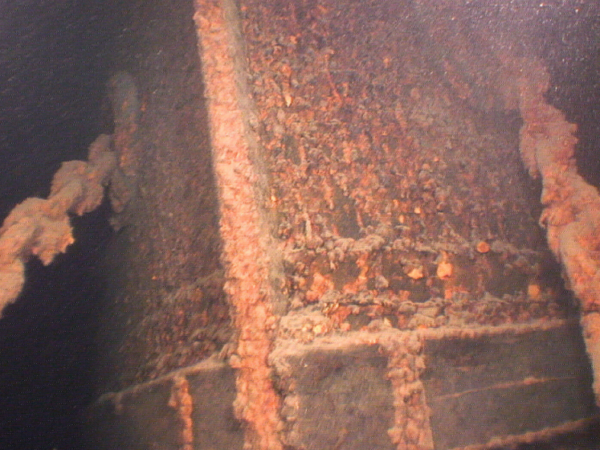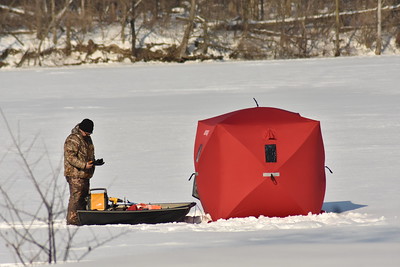
High water and erosion caused the beach stairs in Chikaming Township in southwest Michigan to collapse.
Now, two years later, volunteers have rebuilt those stairs, marking renewed access to some of the township’s most cherished assets – its public beaches – after high water in Lake Michigan rendered them unusable.
“That’s what people move here for. They’re a great asset to the township,” said Arthur Aderson, the chair of the Chikaming Township parks board.

A volunteer removes a beach closed sign after the helping to rebuild beach stairs that had washed away. (Photo courtesy of Chikaming Township)
The stairs were rebuilt at two beaches, one in 2020 and one in 2021, after receding water made room for them.
Erosion and high lake levels have caused problems around the Great Lakes basin for more than just beach stairs. They’ve threatened homes and toppled them into the lake, damaged roads and shrunk beaches.
But after two years of record-smashing water levels around the Great Lakes, lake levels around the basin are expected to fall this year, though most will remain above average.
“We’re not expecting any water level records,” said Christopher Warren, chief of watershed hydrology at the US Army Corps of Engineers Detroit branch office, which puts out six-month forecasts for Great Lakes water levels.
The most recent forecast predicts lakes Superior, Michigan, Huron and Erie will likely remain above the long-term average, while Lake Ontario will be close to the long-term average. Lake Ontario fell below the long-term average earlier this year.
In April, the average water level in Lake Superior was down almost six inches from April 2020, according to the Great Lakes dashboard provided by the National Oceanic and Atmospheric Administration’s Great Lakes Environmental Research Laboratory. In lakes Huron and Michigan, which technically form a single lake, and in Lake Erie the average level was down over a foot. In Lake Ontario it was down over two feet from April last year.
Lake levels are largely determined by evaporation and precipitation that falls on or runs into the lakes. Since November 2020, the Great Lakes basin has received less-than-average precipitation each month
In March, the basin has received 68% of the average amount, Warren said.
The start of long term decline?
Great Lakes water levels are cyclical, though those cycles might be changing.
Researchers have identified a 13-year cycle between Great Lakes water levels peaking: waters rise for about six year then fall for about six years before rising again. The projected decrease in lake levels could be the start of a longer decline.
“If I had to bet, that’s what I’d guess would happen just because that’s what nature usually does,” said Joe Atkinson, professor and chair of the department of civil, structural and environmental engineering at University at Buffalo.
But at the same time, changing weather patterns could be changing lake level patterns.
“I would say the hydrologic behavior is changing,” Atkinson said.
The fourth national climate assessment predicts an increase in precipitation, which has already increased 5 to 15 percent since the first half of the 20th century. At the same time, ice cover may decrease, allowing for more evaporation. Overall, climate change could cause a decline of 6 inches in lakes Michigan and Huron and less in the other Great Lakes, the assessment says.
“We don’t know in the long term sense what climate change will bring,” Warren, of the US Army Corps of Engineers, said. “It could be higher volatility. It could be a lot of things.”
In the early 2000s, an uncharacteristic spell of low water levels had the scientific community thinking the lakes had found a new, lower normal, he said. Recent years have proven that’s not true. Whether climate change is going to fundamentally change something about water levels in the Great Lakes isn’t yet understood.
“The paradigm that is understood is: we’re not sure,” Warren said.
A level of relief for shoreline residents?
Another area of uncertainty: It’s hard to say whether or not home and business owners will feel any sort of relief from the erosion threat of the last few years, Warren said.
“Erosion is just a really location specific issue,” he said. “My beach might be several hundred feet of gorgeous sand and my neighbor a few miles down the shore could be a bluff.”
This year it’s likely that wind and waves will continue to cause erosion.
The US Army Corps of Engineers saw an uptick in permit applications the last two years, but that number seems to be declining this year. Many shoreline structures meant to combat beach erosion, like sea walls or riprap installations, require a permit from the Army Corps of Engineers.
According to Emily Schaefer, a US Army Corps of Engineers public affairs specialist, the corps received 3,080 total permit applications in 2019 and a whopping 5,085 in 2020. In 2021, it has received 1,753 by late April. The average March from 2014-2019 saw 245 permits. Last year in March 519 applications came in while only 288 came in this year.
These permit applications include those for projects unrelated to erosion as well, but the spike in 2020 corresponds to a reported increase in erosion control projects around the Great Lakes basin.
Catch more news on Great Lakes Now:
Salt Levels: The effects of wintertime de-icing linger in Toronto-area rivers in the summer
In Michigan, rising lake levels disturb sacred ground
Flooding Tells ‘Two Different Stories’ In Michigan
API key not valid. Please pass a valid API key.Featured image: Volunteers rebuild stairs and restore beach access at Harbert Beach in Chikaming Township. (Photo courtesy of Chikaming Township)




